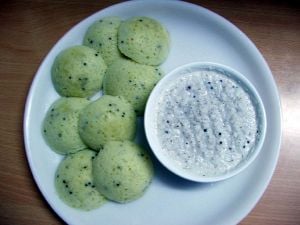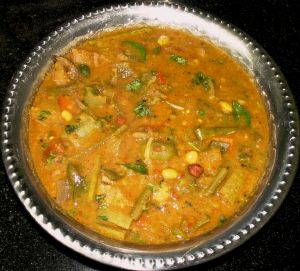Regional Influence On Indian Dishes
Additional Information
Northern
Tandoori chicken is a popular dish in Punjabi cuisine. Kebabs are an important part of Uttar Pradesh's cuisine
North Indian cuisine is distinguished by the proportionally high use of dairy products; milk, paneer, ghee (clarified butter), and yoghurt (yogurt, yoghourt) are all common ingredients. Gravies are typically dairy-based. Other common ingredients include chilies, saffron, and nuts.
North Indian cooking features the use of the "tawa" (griddle) for baking flat breads like roti and paratha, and "tandoor" (a large and cylindrical coal-fired oven) for baking breads such as naan, and kulcha; main courses like tandoori chicken are also cooked in the "tandoor," a cylindrical shaped clay oven. Other breads like puri and bhatoora, which are deep fried in oil, are also common. Goat and lamb meats are favored ingredients of many northern Indian recipes.
The samosa is a popular North Indian snack, and now commonly found in other parts of India, Central Asia, North America, Africa and the Middle East. A common variety is filled with boiled, fried, or mashed potato. Other fillings include minced meat, cheese (paneer), mushroom (khumbi), and chick pea.
The staple food of most of North India is a variety of lentils, vegetables, and roti (wheat based bread). The varieties used and the method of preparation can vary from place to place. Popular snacks, side-dishes and drinks include mirchi bada, buknu, bhujiya, chaat, kachori, imarti, several types of pickles (known as achar), murabba, sharbat, aam panna and aam papad. Popular sweets are known as mithai (meetha means sweet in Hindi), such as gulab jamun, jalebi, peda, petha, rewdi, gajak, bal mithai, singori, kulfi, falooda, khaja, ras malai, gulkand, and several varieties of laddu, barfi and halwa.
Some common North Indian foods such as the various kebabs and most of the meat dishes originated with Muslims’ incursions into the country. Pakistani cuisine and north Indian cuisine are very similar, reflecting their shared historic and cultural heritage.
Eastern
East Indian cuisine is famous for its desserts, especially sweets such as rasagolla, chumchum, sandesh, rasabali, chhena poda, chhena gaja, and kheeri. Many of the sweet dishes now popular in Northern India initially originated in the Bengal and Orissa regions. Apart from sweets, East India cuisine offers delights made of posta (poppy seeds).
Traditional Bengali cuisine is not too spicy, and not too faint. General ingredients used in Bengali curries are mustard seeds, cumin seeds, black cumin, green chillies and cumin paste. Mustard paste, curd, nuts, poppy seed paste and cashew paste are preferably cooked in mustard oil. Curries are classified into bata (paste), bhaja (fries), chochchoree (less spicy vaporized curries) and jhol (thin spicy curries). These are eaten with plain boiled rice or ghonto (spiced rice). A traditional Bengali breakfast includes pantabhat (biotically degenerated boiled rice), doi-chirey, and doodh-muree with fruits. Bangladesh's cuisine is very similar to that of West Bengal, corresponding to the link between Pakistani and northern Indian cuisine. Fish is commonly consumed in the eastern part of India, most especially in Bengal.
Rice is the staple grain in Eastern India, just as it is in South India. A regular meal consists of many side dishes made of vegetables. The popular vegetable dishes of Orissa are Dalma and Santula. The most popular vegetable dish of Bengal is Sukto. Deep-fried, shallow-fried and mashed vegetables are also very popular. Fish is frequently featured in a regular meal.
Southern
 Idlis with coconut chutney, a well-known dish from southern India
Idlis with coconut chutney, a well-known dish from southern India Sambar kadamba.
Sambar kadamba.
South Indian cuisine is distinguished by a greater emphasis on rice as the staple grain, the ubiquity of sambar (also called saaru, a vegetable stew based on a broth made with tamarind and toovar dal) and rasam (also called rasa, a soup prepared with tamarind juice or tomato, pepper and other spices), a variety of pickles, and the liberal use of coconut and particularly coconut oil and curry leaves. The dosa, poori, idli, vada, bonda and bajji are typical South Indian favorites and are generally consumed as breakfast. Hyderabadi biryani, a popular type of biryani, reflects the diversity of south Indian cuisine.[7]
Andhra, Chettinad, Tamil, Hyderabadi, Mangalorean, and Kerala cuisines each have distinct tastes and methods of cooking. Each of the South Indian states has a different way of preparing sambar; a connoisseur of South Indian food can easily tell the difference between sambar from Kerala, sambar from Tamil cuisine, Sambar from Karnataka and pappu chaaru in Andhra cuisine. Some popular dishes include the biryani, ghee, rice with meat curry, seafood (prawns, mussels, mackerel) and paper thin pathiris from Malabar area.
Tamil cuisine generally classifies food into six tastes: sweet (milk, butter, sweet cream, wheat, ghee (clarified butter), rice, honey); sour (limes and lemons, citrus fruits, yogurt, mango, tamarind); salty (salt or pickles); bitter (bitter gourd, greens of many kinds, turmeric, fenugreek); pungent (chili peppers, ginger, black pepper, clove, mustard) and astringent (beans, lentils, turmeric, vegetables like cauliflower and cabbage, cilantro). Traditional Tamil cuisine recommends that all of these six tastes be included in each main meal to provide complete nutrition, minimize cravings and balance the appetite and digestion. A typical meal, served on a banana leaf, includes steamed rice along with a variety of vegetable dishes like sambar, dry curry, rasam and kootu. Meals are often accompanied by crisp appalams. After a final round of rice and curds or buttermilk, or both, a meal is concluded with a small banana and a few betel leaves and nuts.
Copyright © 2018 orchid - All Rights Reserved.
Powered by GoDaddy